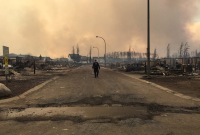Support strong Canadian climate journalism for 2025
A vicious wildfire nicknamed "the beast" hasn't caused too much trouble for nearly 200 beasts that roam a reclaimed oilsands mine north of Fort McMurray, Alta.
Greg Fuhr, vice president of mining and extraction with Syncrude Canada, said Friday that the bison herd on the company's Mildred Lake property is doing well, even with fires raging nearby.
Syncrude was one of the oilsands sites evacuated early this week as the flames encroached, but critical staff who remain have checked in on the animals daily.
"We ensure before we leave that the water troughs are full and that they've got a lot of feed there," Fuhr said in an interview.
The full-time manager of the Beaver Creek Wood Bison Ranch has also flown in periodically, most recently on Friday. He reported back that the ruminants are "acting very normal" and that a few calves have even been born over the past day or so, said Fuhr.
When the wildfire began to cause serious problems for the city of Fort McMurray, about 50 kilometres south, on May 3, the animals were corralled into one area.
The pasture they're in is far to the north and has a big buffer zone separating it from the boreal forest. The workers have checked to make sure that the fence surrounding them is in good shape, so they don't wander out.
Wood bison are "adaptable" creatures and the smoke hasn't bothered them, said Fuhr.
"Actually, one of the interesting things about the smoky conditions is that the number of insects that would typically irritate them are not around."
The herd, co-managed with the Fort McKay First Nation, lives on a depleted oilsands mine that's been filled in and planted with vegetation. Syncrude brought the bison to its property in 1993 to help it learn about how the reclaimed land would support large mammals.
The herd's population has fluctuated over the years, but sat at 190 prior to this year's calving season.
The Canadian Press





Comments